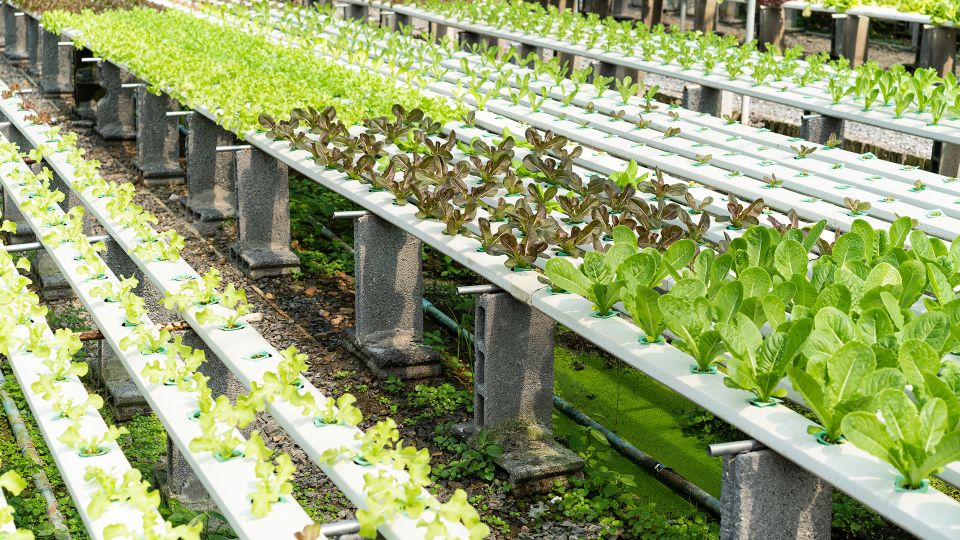Grow Like a Pro: 10 Plants Perfect for Hydroponics Gardening

Imagine a world where you can grow your favorite plants, vegetables, and herbs year-round, without the hassle of soil and pests.
A world where you can control every aspect of your plant's growth, from the temperature and light to the nutrients and water. That world is possible with hydroponics gardening.
But what exactly is hydroponics?
What is Hydroponics?

Hydroponics is a method of growing plants with water, nutrients, and a growing medium instead of soil. It allows you to grow plants faster and with less effort, and it's perfect for DIYers and gardeners who want to try something new and challenging.
It allows you to create a controlled environment for your plants, giving them everything they need to thrive.
Imagine growing juicy tomatoes in the dead of winter or fresh herbs all year round. With hydroponics, the possibilities are endless.
Hydroponics is not only a fun and rewarding hobby but also a sustainable and eco-friendly way to grow your own food. You can even use fish and seaweed fertilizers to give your plants all the nutrients they need without relying on synthetic chemicals.
One of the best things about hydroponics is that you can grow a wide range of plants using this method. Many plants thrive in a hydroponics garden, from vegetables and herbs to flowers and fruit trees.
In this blog post, we'll look at 10 plants that can be grown using hydroponics. We'll also discuss using fish and seaweed fertilizer in hydroponics, a great way to provide your plants with all the nutrients they need to grow strong and healthy.
Ready? Read on!
10 Best Plants to Grow Using Hydroponics

Lettuce
Looking to add some greens to your hydroponics garden? Look no further than lettuce, the ultimate beginner's plant. With its quick growth and low space requirements, lettuce is perfect for small hydroponics gardens. Whether you choose a floating raft system or a nutrient film technique (NFT) system, lettuce is sure to thrive.
Tomatoes
If you're in for something sweeter, consider growing tomatoes in your hydroponics garden. These popular plants grow well in a nutrient film technique (NFT) system or a deep-water culture (DWC) system. Just be sure to provide them with plenty of nutrients using a good quality hydroponics fertilizer.
Cucumbers
Looking for something a little crunchier? Why not try growing cucumbers in your hydroponics garden? These quick-growing plants don't take up much space, making them a great choice for small hydroponics gardens. Just be sure to maintain a consistent temperature to keep them happy.
Peppers
Peppers are another popular choice for hydroponics gardening. Whether you choose a nutrient film technique (NFT) system or a floating raft system, peppers require plenty of light to thrive. Make sure to provide them with plenty of light in your hydroponics garden.
Basil, Rosemary, Thyme
Basil, rosemary, and thyme are all popular herbs that thrive in a hydroponics garden. Whether you choose a nutrient film technique (NFT) system or a floating raft system, these herbs all require plenty of light to grow. So be sure to provide them with plenty of light in your hydroponics garden.
Mint
Mint is a popular herb that grows well in a hydroponics garden. It grows well in a nutrient film technique (NFT) or floating raft system. Mint requires a lot of light to grow, so it's important to provide plenty of light in your hydroponics garden.
Hydroponic strawberries
If you're a fan of sweet, juicy berries, consider growing hydroponic strawberries in your hydroponics garden. These fast-growing plants produce a high yield and thrive in a nutrient film technique (NFT) system or a floating raft system. Just be sure to provide them with plenty of light to help them grow to their full potential.
Hydroponic blueberries
If you're looking for something a little tart, why not try growing hydroponic blueberries in your hydroponics garden? These fast-growing plants produce a high yield and thrive in a nutrient film technique (NFT) system or a floating raft system. Just be sure to provide them with plenty of light to help them grow to their full potential. Whether you prefer sweet or tart, these hydroponic berries are sure to satisfy your cravings.
Steps to Fertilize Your Hydroponics Garden

There are a few steps to follow when fertilizing your hydroponics garden:
- Choose a fertilizer: There are many different types of fertilizers available for use in hydroponics, including synthetic fertilizers, organic fertilizers, and fish and seaweed fertilizers. Consider the needs of your plants and your personal preferences when choosing a fertilizer.
- Mix the fertilizer: Follow the instructions on the fertilizer label to determine the correct dosage for your plants. Mix the fertilizer into the water or growing medium according to the manufacturer's recommendations.
- Test the pH: It's important to test the pH of the water or growing medium regularly to ensure it is within the optimal range for plant growth. pH test strips or a pH meter can be used to measure the pH of your hydroponics system.
- Apply the fertilizer: Once you have mixed the fertilizer and checked the pH, it's time to apply it to your hydroponics system. Depending on the type of system you are using, this may involve adding the fertilizer to the water or nutrient solution, or applying it directly to the growing medium.
- Monitor and adjust: Keep an eye on your plants to ensure they are receiving the right amount of nutrients. If you notice any issues with plant growth or health, consider adjusting the dosage or frequency of fertilization.
It's important to follow the instructions on the fertilizer label and pay attention to the needs of your plants to ensure successful fertilization in your hydroponics garden.
Benefits of Using fish and Seaweed Fertilizer in Hydroponics

Fish and seaweed fertilizers are great options for hydroponics gardening because of these:
- Provide plants with a wide range of nutrients.
Fish fertilizer is made from fish emulsion, which is created by grinding fish and mixing it with water. Seaweed fertilizer is made from seaweed, which is a natural source of nutrients.
- Natural and organic.
They give plants the nutrients they need to grow strong and healthy without synthetic chemicals. Fish and seaweed fertilizers are also great for the environment, because they are sustainable and biodegradable.
When using fish and seaweed fertilizers in your hydroponics garden, it's important to follow the instructions on the packaging.
Overfertilizing can lead to excess nutrients in the water, which can be harmful to plants. It's also important to monitor the pH levels in your hydroponics garden to ensure that the plants receive the proper nutrients.
Introducing PetraTools Fish & Seaweed Fertilizer

PetraTools' Liquid Fish & Seaweed Fertilizer is the ultimate one-two punch for your soil, providing essential nutrients and minerals to help your plants thrive.
It is made with a special blend of North Atlantic seaweed and American hydrolyzed fish; this super-charged formula is ready to use right out of the bottle.
Add it to your soil and watch your plants grow to new heights.
Whether trying to cultivate a bountiful vegetable garden, beautiful flowers, or even a luscious lawn, this fish and seaweed fertilizer has got you covered.
Final thoughts
In conclusion, hydroponics gardening is a fantastic way to grow a wide range of plants in a controlled environment.
From lettuce and tomatoes to herbs and fruit trees, there are many plants that thrive in a hydroponics garden. When it comes to fertilizing your hydroponics garden, fish and seaweed fertilizers are a great option. They are natural, organic, and sustainable, providing your plants with all the nutrients they need to grow strong and healthy.
If you're looking for a high-quality fish and seaweed fertilizer for your hydroponics garden, we recommend PetraTools' Liquid Fish & Seaweed Fertilizer.
This ready-to-use formula is made with a special blend of North Atlantic seaweed and American hydrolyzed fish, and it's perfect for indoor and outdoor plants, including vegetables, flowers, trees, seeds, and even lawns.
So why not give PetraTools' Liquid Fish & Seaweed Fertilizer a try and see the amazing results for yourself?






